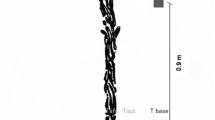Abstract
Acclimation in response to a decreasing daylength prior to the onset of low temperatures can be critical to the winter survival and productivity of many woody plants. This is particularly true for temperate fruit crops such as grapes. Grapes are native to the northern hemisphere, however they have a very large production range extending from the subtropics to 50 N and S latitude. Acclimation and freezing tolerance characteristics of this high value crop are very important as many production regions incur damaging freezes in fall, winter or spring. Typically production regions are recommended on the basis of the midwinter low temperatures; however, in many North American growing areas, injury during unseasonable low temperatures in the fall when the canes are maturing and acclimating can be as damaging as low midwinter temperatures (Bordelon et al., 1997, Clore et al., 1974, Seyedbagheri and Esmaeil, 1994). Therefore, a better understanding of the mechanisms involved in the onset of acclimation and freezing tolerance in grapes is needed to improve cultivar selection and cultural practices to minimize losses due to freezing injury.
Access this chapter
Tax calculation will be finalised at checkout
Purchases are for personal use only
Preview
Unable to display preview. Download preview PDF.
Similar content being viewed by others
References
Andrews, P. K., Sandidge III, C. R., and Toyama, T. K., 1984, Deep supercooling of dormant and deacclimating Vitis buds, Am. J. Enol. Vitic. 35: 175–177.
Bordelon, B. P., Ferree, D. C., and Zabadal, T .J., 1997, Grape bud survival in the midwest following the winter of 1993–1994, Fruit Var. J. 51: 53–59.
Clore, W. J., Wallace, M. A., and Fay, R. D., 1974, Bud survival of grape varieties at sub-zero temperatures in Washington, Amer. J. Enol. Vitic. 25: 24–29.
Faust, M., Liu, D., Millard, M. M, and Stutte, G. W., 1991, Bound versus free water in dormant apple buds - A theory for endodormancy, HortScience 26: 887–890.
Faust, M., Erez, A., Rowland, L. J., Wang, S. Y., and Norman, H. A., 1997, Bud dormancy in perennial fruit trees: Physiological basis for dormancy induction maintenance and release, HortScience 32: 623–629.
Fennell, A., and Hoover, E., 1991, Photoperiod Influences Growth, Bud Dormancy, and Cold Acclimation in Vitis labruscana and V. riparia,J. Amer. Soc. Hort. Sci. 116: 270–273.
Fennell, A., Wake, C., and Molitor, P., 1996, Use of 1H-NMR to determine grape bud water state during the photoperiodic induction of dormancy, J. Amer. Soc. Hort. Sci. 121:1112–1116.
Fennell, A., and Line, M. J., 2001, Identifying tissue response in grapes during induction of endodormancy using magnetic resonance imaging, J. Amer. Soc. Hort. Sci. 126: 681–688.
Jones, K. S., McKersie, B. D., and Paroschy J. , 2000, Prevention of ice propagation by permeability barriers in bud axes of Vitis vinifera, Can. J. Bot. 78: 3–9.
Liang P., and Pardee, A. B., 1992, Differential display of eukaryotic messenger RNA by means of the polymerase chain reaction, Science 257: 967–971.
Liu, D., Faust, M., Millard, M. M., Line, M. J., and Stutte, G. W., 1993, States of water in summer-dormantapple buds determined by proton magnetic resonance imaging, J. Amer. Soc. Hort. Sci. 118: 632–637.
Millard, M. M., Veisz, O. B., Krizek, D. T., Line, M., 1995, Magnetic Resonance Imaging (MRI) of Water During Cold Acclimation and Freezing in Winter Wheat, Plant Cell Environ. 18: 535–544.
Quamme, H. A., 1986, Use of thermal analysis to measure freezing resistance of grape buds, Can J. Plant Sci. 66: 945–952.
Schnabel, B.J. and R.L. Wample, 1987, Dormancy and Cold Hardiness in Vitis vinifera L. cv. White Riesling as Influenced by Photoperiod and Temperature, Amer. J. Enol. Vitic. 38:265–272.
Seyedbagheri, M.M., and Esmaeil, F., 1994, Physiological and environmental factors and horticultural practices influencing cold hardiness of grapevines, J. Small Fruit Vitic. 2: 3–38.
Wake, C. F. M. and Fennell, A., 2000, Morphological, physiological and dormancy responses of three Vitis genotypes to short photoperiod, Physiol. Plant. 109: 203–210.
Author information
Authors and Affiliations
Editor information
Editors and Affiliations
Rights and permissions
Copyright information
© 2002 Springer Science+Business Media New York
About this chapter
Cite this chapter
Fennell, A., Mathiason, K. (2002). Early Acclimation Response in Grapes (VITIS). In: Li, P.H., Palva, E.T. (eds) Plant Cold Hardiness. Springer, Boston, MA. https://doi.org/10.1007/978-1-4615-0711-6_8
Download citation
DOI: https://doi.org/10.1007/978-1-4615-0711-6_8
Publisher Name: Springer, Boston, MA
Print ISBN: 978-1-4613-5205-1
Online ISBN: 978-1-4615-0711-6
eBook Packages: Springer Book Archive




